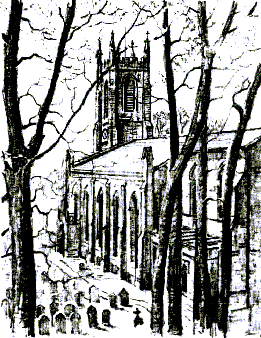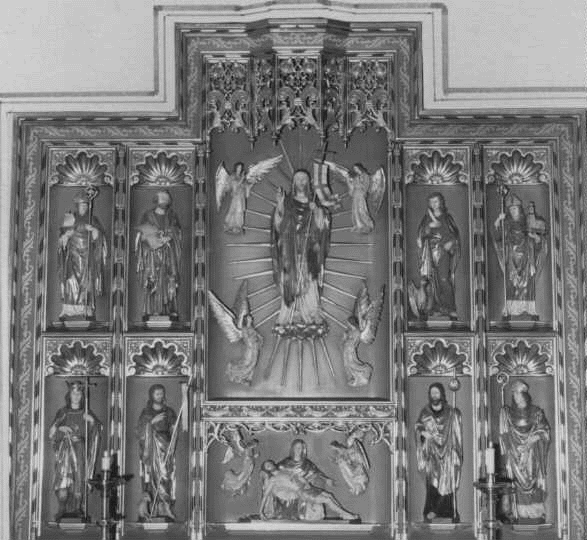
Back to home
The Reredos
The colourful object behind the altar is the reredos. It was unveiled on Easter day 1934 having been commissioned to mark the Church centenary in 1933. It is made of oak covered in gold gilt and painted. The figures were carved in North Italy but all the other carving together with the painting and gilding was performed in this country.
Key to the figures
|
1 |
2 |
3 |
4 |
5 |
|
6 |
7 |
8 |
9 |
10 |
1 St Wilfred representing the Diocese of Ripon which Halifax Parish was originally part of
2 St Peter representing the Diocese of York, Wakefield is in the Archdiocese of York. Hebden Bridge was within the Diocese of York on its foundation in 1833 and the Church was consecrated by the Archbishop of York.
3 The ascending Christ surrounded by 4 Angels.
4 St. John the Evangelist was the patron saint of the sister Church of St. James, St. Johns. This has now been demolished.
5 St Paulinus known as the Church builder
6 St Oswald aka King Oswy of Northumbria. He has already had a strong press in the Journal.
7 St John the Baptist, another John, is the patron saint of Halifax Parish Church. St James Church was a Chapel within Halifax Parish until 1844 when Hebden Bridge became a Parish.
8 The Virgin Mary holding the body of her dead son.
9 St James the Great our very own patron saint
10 St Aidan, fist Bishop of Lindisfarne (635) one of the men responsible to bringing (Celtic) Christianity to the pagan North.
All the above should either be well known or you can look them up in back issues of the Journal except St. Paulinus. Worry not, he is not there just to make up the numbers although he was Italian (like the sculptor of the reredos). In 601 Paulinus was sent with St. Mellitus (later first bishop of London) and St. Justus (later first bishop of Rochester) to England by Pope St. Gregory I the Great to assist Archbishop St. Augustine of Canterbury in his mission of converting England to Christianity. Augustine had been there since 597 accompanied by about 40 monks. He survived and sent a report back to Rome. The result was a pallium for Augustine allowing him to consecrate Bishops and clerical reinforcements including Paulinus. Paulinus was consecrated bishop at Kent (625) by Justus (then fourth archbishop of Canterbury, Augustine died in 604) and escorted the (Christian) daughter of King Aethelberht (Ethelbert) of Kent to the (Pagan) Northumbrian king Edwin. Paulinus converted and baptized Edwin (627), who made him first bishop of York, after which Paulinus' missions spread throughout Northumbria (hence the Church builder bit). When in 632 Edwin was slain by the Anglo-Saxon Mercian and Welsh Gwynedd kings, Paulinus fled to Kent, where he became bishop of Rochester. He was promoted to Archbishop of Rochester in 634. Edwin's Kingdom was rebuilt by his nephew Oswy the Synod of Whitby man. To recap, Edwin had been converted by the Catholic Paulinus but Oswy had been out of favour at the time of Paulinus and had run off to Iona where he was converted from the pagan tradition to Celtic Christianity.
